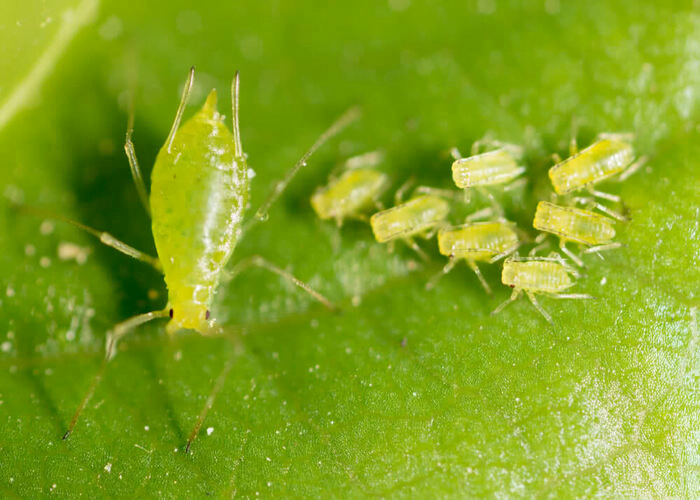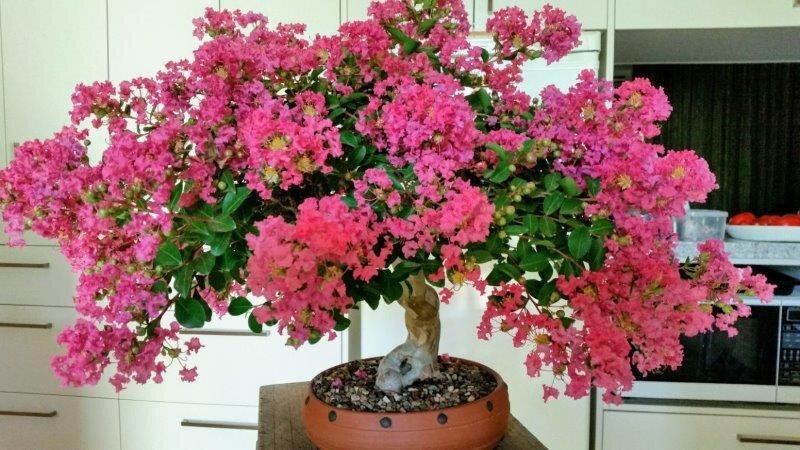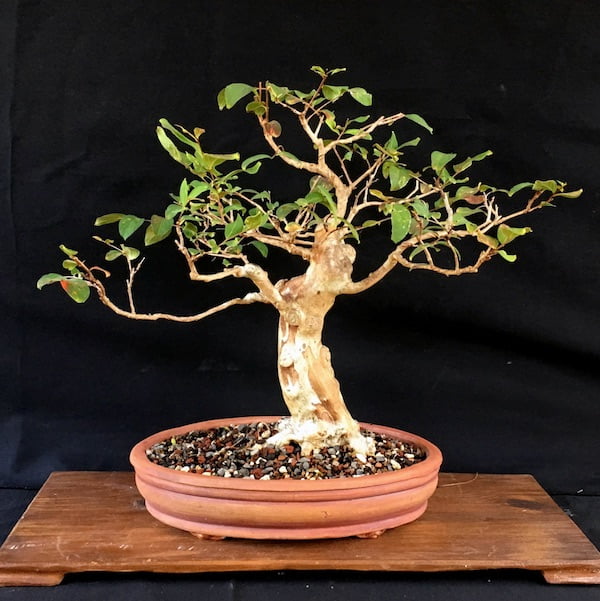There are a lot of interesting colors in the bark of crepe myrtle tree, including gray, pink, cream, tan, and brown. You can see mottled inner bark under the bark that peels off in thin flakes.
Also, a big reason this tree is so popular is the six-petaled flowers that bloom from June to September. Additionally, in the fall, dark green leaves turn red, yellow, and orange.

Crepe Myrtle Bonsai Quick Facts
| Fact | Description |
|---|---|
| Scientific Name | Lagerstroemia indica |
| Family | Lythraceae (loosestrife Family) |
| Native to | China, Indochina, the Himalayas, and Japan. |
| Lifespan | 100 years |
| Height | 100 feet |
| Leaves | Green oval shaped |
| Fall foliage | Bright yellow to deep red-orange. |
| Flower | Deep lilac, pink, to white |
| Cultivation | Bonsai plants |
| Symbolism | Love, beauty longevity, good fortune |
| Uses | Ornamental plants |
Crepe Myrtle Bonsai Care Guide
You can enjoy a stunning and rewarding crepe bonsai collection by following these guidelines. Moreover, to keep your plant in peak condition, keep an eye on its health and adjust your care routine accordingly.
Crepe Myrtle Bonsai Watering
Water requirements for crepe myrtles are medium and they prefer consistently moist soils. Also, it is drought-tolerant once established, but it does require deep watering once or twice per month.
Moreover, it is important that you never neglect watering crepe myrtles. Always water your plants when the soil appears dry. Also, never let the soil dry completely.
It may be necessary for you to water your bonsai more frequently if it receives full sun. However, these may vary depending on the type of soil and pot size.
If you are a new parent to crepe myrtles, I suggest you use a moisture meter. For watering crepe bonsai, you can use cans or hose attachments.
Learn more about Watering a bonsai tree.
Crepe Myrtle Bonsai Temperature Tolerance
If you’re growing it indoors, keep the temperature around 45-54 degrees during the winter.
Also, it’s best to keep the temperature and lighting consistent, as a constantly changing environment can stunt the growth of crepe myrtle.
Right Placement for Crepe Myrtle Bonsai
It is best to place this bonsai tree in full sun. This will promote flowering and prevent diseases and pest infestations.
You can place crepe myrtles outside all year round in a warm position. However, while transferring bonsai to a temperate climate, put it in a cool, frost-free location.
Repotting Crepe Myrtle Bonsai
Usually, crepe myrtle needs repotting every 2-3 years. And the best time to repot them is in mid-summer.
To begin with, remove the bonsai from the pot along with the soil. Also, remove the outer and bottom fourth of the tree’s root mass. Additionally, avoid pruning more than a fourth of the tree’s root mass.
Once this is done, you can put the crepe myrtle tree back in its original pot or into another. Next, put a screen over the drainage holes on the pot. In the bottom of the pot, you put a thin layer of gravel to drain it.
On top of the gravel, put the new soil. Spread a layer of well-draining soil to elevate the tree to its previous height.
Also, when you put the tree back in the pot, fill in the empty area left by the pruned root mass with fresh soil. Make sure you don’t leave any air pockets under and around the root mass.
After repotting, water the crepe myrtle well. You can do this by submerging the entire pot in water. Also, to prevent soil erosion when watering, cover the pot surface with moss.
Best Soil for Crepe Myrtle Bonsai
Crepe Myrtle thrives in free-draining, well-aerated soil. However, it also needs organic matter (about 40% organic matter is best, composted bark is a good choice) to grow, especially in the summer and spring.
Additionally, you can grow crepe myrtles in a lot of soil types, from slightly alkaline to acidic. But, crepe myrtle bonsai likes moist, well-drained soil. Furthermore, they can handle drought if necessary. On the pH scale, crepe myrtle likes soil between 5.0 and 6.5.
How to Guides for Crepe Myrtle Bonsai
You can encourage a crepe myrtle growth and flourish by pruning, wiring, fertilizing, and propagating it properly. Also, take action to treat and prevent common problems and pests that may affect bonsai, like aphids and mildew. Overalll, for years to come, a Crepe Myrtle Bonsai can bring you beauty, grace, and health.
How to Prune Crepe Myrtle Bonsai
Unlike other bonsai plants, Crepe Myrtle Bonsai is pretty easy to shape. However, you just need to be careful of the flowers.
It’s best to prune Crepe Myrtle Bonsai in the fall so you’ll get more buds next year. However, if you prune too much, you might end up with no flowers.
Furthermore, I usually recommend cutting the tree back a bit and then letting it grow freely for a year. In this way, you’ll get a thicker trunk.
If you want better branch growth, pinch the tree continuously for a year. Also, despite pruning, there’s a chance your tree will bloom before budding.
How to Wire a Crepe Myrtle Bonsai
Putting wire in a Crepe Myrtle is possible, but take care not to damage its bark. You need to carefully wrap copper or aluminum wire around the branches of a Crepe Myrtle bonsai in order to shape it. Also, make sure to wrap the wire with paper or tape before winding it around the branches. You can wire a Crepe Myrtle bonsai by following these steps:
- Select copper or aluminum wire that is approximately one-third the branch’s thickness.
- Wrap the wire around the branch starting from its base, leaving an inch’s length of wire tail.
- Once the wire is firm, run it along the branch, making sure it isn’t too tight or too loose.
- From the base of the branch, spiral the wire up in a spiral pattern. Don’t let the wire cut into the bark. Additionally, it should hold the branch in place, but it shouldn’t be too tight.
- After the wire is placed, gently bend the branch into the desired shape. Avoid snapping or damaging the crepe myrtle bark.
- Continue shaping branches until crepe myrtle bonsai are all wired and shaped. Regularly inspect the wires to ensure they don’t damage the bark or restrict nutrients of crepe bonsai. Also, you can loosen the wires if they’re too tight.
- After a few months, the branches will have formed into their new shape. Unwind the wire from the branch carefully so the bark and leaves are not damaged.
Learn more about How to Wire a Bonsai Tree Branch
How to Fertilize Crepe Myrtle Bonsai
In the growing season, feed crepe bonsai every other week with a well-balanced fertilizer to encourage new growth. During the winter, reduce the frequency to once a month.
Moreover, you can alternate low nitrogen and balanced fertilizer if you have some tomato fertilizer. You’ll get more buds this way.
Check this detailed guide on How to Fertilize your Bonsai Trees the Correct Way
How to Grow a Crepe Myrtle Bonsai
It’s easy to grow crepe mrytle bonsai from seeds and cuttings. However, it’s easier to germinate seeds than cutting them. Still, let’s take a look at both methods.
How to Grow Crepe Myrtle Bonsai from Seed
It’s pretty easy for Crepe Myrtle seeds to germinate. Place your Crepe Myrtle seeds directly in paper cups or bonsai pots with high-quality bonsai soil.
Make sure the soil is wet before you plant seeds. After your pot is ready, press seeds gently into the surface.
Check this detailed guide on How to grow a bonsai tree from seed?
How to Grow Crepe Myrtle Bonsai from cutting
- Pick a young, green crepe myrtle stem that hasn’t yet become woody. Aim for 6-8 inches.
- Just below a leaf node, cut the stem at a 45-degree angle with a sharp pruning shear. Also, take off any leaves or buds from the lower 2/3.
- Dip the cut end in rooting hormone powder. It’ll encourage root growth.
- Make a soil mixture with organic matter, perlite, and vermiculite in a small container.
- Put the cutting in the center of the soil. Make sure the soil is firmly pressed around the stem.
- Put the pot in indirect sunlight. Additionally, keep cutting out of direct sunlight.
- Water the soil, but don’t drown it. Use a gentle mist or bottom watering to water the cutting.
- Upon rooting, transplant the cutting into a larger pot with bonsai soil.
Common Crepe Myrtle Bonsai Problems and Solutions / Diseases & Pests
1. Aphids

These insects have pear-shaped bodies with long legs and antennae. They may be green, yellow, brown, red, or black depending on their species and food source. Additionally, aphids appear waxy or woolly because they secrete a waxy white or gray substance over their body.
Solution: Spray them with an insecticide or wash them off with a strong jet of water.
2. Mildew

A serious problem for crepe myrtles is mildew. In moist areas, mildew can be easily identified as a patch of gray or even white fungus lying on the leaves surface.
Solution: Add 1 tablespoon potassium bicarbonate and 1/2 teaspoon liquid soap (not detergent). Spritz generously on all affected areas. Also, a mixture of this and baking soda works better for existing mildew infections. You can also spray generously with milk mixed with 2 to 3 parts water.
Crepe Myrtle Bonsai Images




